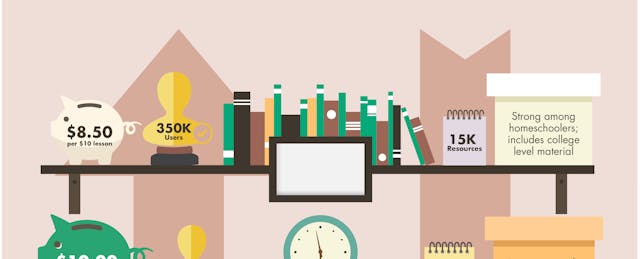Ever since she started teaching nine years ago, Kelley Dolling, now a first-grade teacher at Antelope Elementary School in northern California, has enjoyed creating her own lessons and classroom materials. Her colleagues admired the quality of her ingenious creations, from bulletin boards with paper french fries for lessons on plural nouns, to magazine collages that teach different types of sentences. Even more, Dolling’s colleagues appreciated her willingness to share.

Three years ago, a surgical operation kept Dolling out of the classroom for three months. A friend suggested she could stay connected with her colleagues by blogging about her teaching experiences. Better yet, she nudged Dolling to consider sharing—and selling—online the classroom materials she had developed.
“I knew TeachersPayTeachers as a buyer,” recalls Dolling. “I felt comfortable with the platform, but when I first considered uploading my material, I thought it wasn’t for me. I didn’t have time to create an online store.”
In spite of her initial hesitation, Dolling has flourished in the online market for school resources. Today, her TeachersPayTeachers (TPT) store offers 192 items, ranging from free resources to $50 for a bundle of math materials. She also enjoys more than 6,600 followers on the site—a following that she believes has helped boost her brand on social media as well. Dolling has nearly 20,000 followers on Facebook, 9,500 on Instagram, 3,800 on Pinterest and a loyal number of readers of her blog, Teacher Idea Factory. She organizes a pen pal campaign every year to match educators who teach the same grade but live far away from one another. Last year, 800 teachers participated.
Dolling is not alone. Teachers have earned more than $175 million of materials on TPT since its launch in 2006. The platform is the first and the most widely used marketplace for teachers. The most famous seller is Deanna Jump, who in 2012 was the first TPT millionaire. Thirteen other teachers have since passed the $1 million sales mark; another 300 have each earned more than $100,000.
Where Dollars Flow, Competitors Follow
Millions of teachers are avid buyers and sellers in a booming number of marketplaces for teacher-made materials. A recent EdSurge survey identified 9 marketplaces where teachers can sell their creations. Another 6 allow them to share and download resources for free or are open education resources platforms. Together, those marketplaces list more than 26 million free or paid products and serve 15 million users—although some of the resources and users are part of more than one platform. (Marketplaces for education providers where teachers are not allowed to upload classrooms materials were not considered).
Four of the 14 platforms in our survey were launched within the past six months—three of them by startups based in the San Francisco Bay Area. TES, a British company, opened its marketplace for US teachers in August—following the steps of TES UK and TES Australia, similar efforts that launched in 2006 and 2013 respectively.
More are on the way: eduClipper, an online platform where students and share materials, will debut its marketplace by the end of this month. Houghton Mifflin Harcourt, best known for publishing and selling books, plans to launch its marketplace for educators and developers in early 2016.
How did teacher marketplaces become so viral? “Part of the appeal is that the idea of opening a digital marketplace is fairly low-hanging fruit,” says Adam Bellow, founder of eduClipper. However, as the adage goes: content is king. “Opening the store is easy, but as any shop owner would tell you, it is the filling of the store and moving merchandise that is the tough part.”

Who Buys, Who Sells
For many teachers working on thin salaries, these online shops offer a source of additional income. “I’m getting paid for something I would do anyway, which is creating lessons,” says John Hughes, a former elementary school teacher and current principal at Cottonwood Elementary in Orangeville, UT. He sells his materials via five marketplaces: Educents, Teachers Pay Teachers, Teacher’s Notebook, Teachwise and TES.
Teachers who sell resources typically have several years of experience and “a specific knowledge, a desire to become a stronger teacher [by improving their lessons with other teachers’ feedback], who also want to see their classroom materials outside the boundaries of their school,” says Elena Balint, chief marketing officer of Share My Lesson, a network where teachers share their lessons freely among one another.
Marketplaces also offer a brand-building opportunity that can lead to invitations to conferences and networking opportunities. “Those that I teach and work with would probably not describe me any different in the four years that I have been selling,” says Hughes. “On the flip side, I have had access to better networking with other educational professionals.”
These resources can be a lifeline especially for those who are new to the profession. “The life of a first-year teacher is very hard. You have so much to learn, and there are so many adjustments that have to be made,” says Sue Summers, who has taught middle-school Spanish for 19 years and is currently at Horace Mann Middle School in Wausau, WI. “I remember my first year as a teacher and wish I had this type of support back then.” Like Hughes, she has online stores in multiple marketplaces.
Even experienced teachers like Dolling will buy materials. “Although it is my ninth year in the classroom and I am a TPT seller, I am buying resources quite a bit this year as the ballgame has changed,” says Dolling, who only recently started teaching at Antelope Elementary. “I just don’t have time to create it all on my own this first year. I will gladly pay anyone who is offering quality resources that meet my new needs.”

The Art of Selling
Selling materials made from passion can be uncomfortable for some. But top marketplace sellers say teachers should be compensated for their time. Summers sets her prices based on how much time it took for her to create the resource. “When you go to a live performance and like it, you may not realize the amount of effort there was behind the scenes,” she says. “Creating material is the same. People don't always see how much work it took.”
All the marketplaces we surveyed allow sellers to set the prices of their products. But many teachers say they keep the price low—often under $5—out of empathy, knowing that the buyers are often fellow professionals paying out of their own pocket.
"My rule of thumb is to think about what I would like to pay if I were looking for a similar resource. I put myself in my buyer's shoes. I also take into account if the ideas are editable [meaning buyers can manipulate the content], if “extras” are involved [for instance, professionally recorded standards-based songs], and how hard was the creation process," says Dolling.
Teaching is an art. And while the profession pays teachers modestly for their performance in classrooms, online marketplaces offer them an opportunity to be compensated both financially and socially. Going from the isolation of the classroom to becoming a famous online brand may seem scary at the outset. But veteran teacher-sellers assure: you will get used to the fame.



